A Project of the Hudson River Estuary Program
Compiled by Tom Lake, Consulting Naturalist
Overview
Getting a break from eagles and fish, this was a week for non-venomous snakes. Glass eel monitoring ended for the year, the vanguard of Arctic-bound brant arrived from points south, and many more students found their way to the banks of the river to share in the knowledge of our skilled educators.
Highlight of the Week
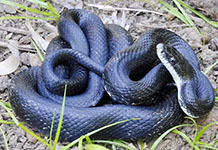 5/19 – Putnam County, HRM 52: This was our first trip to Constitution Marsh Sanctuary – a jewel of a place. Hiking in the hilly wooded section before the boardwalk, we heard a gasp from hikers ahead of us. They had startled a five-foot-long black snake sunning on a rock. The snake hissed at them, slithered into the underbrush, and being very agile and a good climber, went up a tree. (Photo of eastern rat snake courtesy of Virginia Herpetological Society) 5/19 – Putnam County, HRM 52: This was our first trip to Constitution Marsh Sanctuary – a jewel of a place. Hiking in the hilly wooded section before the boardwalk, we heard a gasp from hikers ahead of us. They had startled a five-foot-long black snake sunning on a rock. The snake hissed at them, slithered into the underbrush, and being very agile and a good climber, went up a tree. (Photo of eastern rat snake courtesy of Virginia Herpetological Society)
- Rick Stafford, JoAnn Stafford
[We most likely have two species of non-venomous black snakes (Pantherophis spp.) in New York. In the Hudson River watershed and the eastern Adirondacks, we have what is now called the eastern rat snake (P. alleghaniensis), which was Rick and JoAnn Stafford’s snake. The western New York species is the gray rat snake (P. spiloides). Al Breisch]
Natural History Entries
5/18 – Troy, HRM 152: On a perfect day for birding, nine birders comprised our group for the Oakwood Annual Spring Bird Walk. Three of us added species to our “life lists.” We compiled a total of 39 species including seven different warblers: Black-throated green, northern parula, bay breasted, yellow-rumped, Tennessee, magnolia, and yellow warbler. Other highlights included an immature bald eagle, a pair of scarlet tanagers, Baltimore orioles, osprey, Canada goose (with 3 goslings), and a solitary sandpiper.
- Heidi Klinowski (Hudson-Mohawk Bird Club)
[A “life-bird” or a “life list” is a common activity for many naturalists. Typically, these are compilations of related species, like postcards from one’s travels through life. Some people keep bird lists; for others it can be fish, flowers, insects, mushrooms, fungi. Anyone can keep a list of almost anything that ultimately gives them a context and appreciation for the natural world. Tom Lake]
 5/18 – Albany County, HRM 135: We were kayaking an inlet off the river at the Binnen Kill when we came upon three deadfalls in the water covered with map turtles. We counted no fewer than thirty. Some were shedding their scutes (plate-like scales). (Photo of map turtles courtesy of Sharon Askew) 5/18 – Albany County, HRM 135: We were kayaking an inlet off the river at the Binnen Kill when we came upon three deadfalls in the water covered with map turtles. We counted no fewer than thirty. Some were shedding their scutes (plate-like scales). (Photo of map turtles courtesy of Sharon Askew)
- Sharon Askew, Kelly Halloran
[The northern map turtle (Graptemys geographicaare) gets both its common and scientific names from the markings on the skin and carapace. The light markings resemble contour lines on a map or chart. They are quite common basking turtles along that stretch of the Hudson. I see them frequently at Henry Hudson Park, especially in the mouth of the Vlomankill and on the jetty at Coeymans that runs parallel to the shore. I have watched them basking on the jetty as high tide approaches, and the waves make them dive back into the river. Al Breisch]
5/18 – Yonkers, HRM 18: We held a public seining program at the Sarah Lawrence Center for the Urban River at Beczak for our Spring Family Fun Day as part of Yonkers Arts Weekend. We made 15 hauls of our net and caught striped bass, mummichogs, white perch, and four small blue crabs.
– Jay Muller
5/19 – Ulster County, HRM 76: We were walking our dog around our yard in Kerhonkson not long after sunrise this morning and just minutes after a heavy downpour. Through the sound of the dripping rain hitting the newly emerged leaves, we heard a gobble off in the distance. We tried calling to the wild turkey, but to no avail. Later, looking out the window, we saw an adult black bear standing exactly where we had tried to call the turkey. We watched the bear work its way back and forth through the higher weeds in a field, its nose in the air.
- Jeremy Baracca, Justin Baracca
*** Fish of the Week ***
5/19 – Hudson River Watershed: Week 22 for Fish-of-the-Week is the bowfin (Amia calva). The bowfin is number 16 (of 228) on our watershed list of fishes. (If you would like a copy of our list, e-mail: trlake7@aol.com.)
Bowfin (Amia calva) are an ancient and rugged predator species in the taxonomic realm of sharks and sturgeon. Their order (Amiiformes) arose in the Triassic Period 250 million years ago, and their family (Amiidae) is known from the Cretaceous 100 million years ago. The bowfin lineage has endured many global cataclysms. From those times, it carries an adaptation to be able to assimilate atmospheric oxygen by using the swim bladder to survive in waters with very low dissolved oxygen.
Their native range extends from the Saint Lawrence and Ottawa rivers and Lake Champlain west through the Great Lakes. In New York, bowfin can be found in the Great Lakes, Saint Lawrence River, Lake Champlain, and the Hudson River watershed where it has been introduced. They are well established in the upper Hudson River having possibly migrated down the Hudson-Champlain Canal from Lake Champlain and have extended their range downriver to at least Norrie Point (river mile 85).
Bowfin are a voracious predator; their mouth contains rows of sharp teeth, and for some, they are a prize gamefish. They will hit artificial lures and seem particularly fond of the color purple (Randy Jackson). The current state record is a 12-pound 14-ounce fish caught in Lake Champlain. Tom Lake]
5/19 – Walden, HRM 65: I walked around the loop trail at Winding Hills Park on our first rainless day in a while. Approaching the dam where I usually look for water snakes (non-venomous), I was surprised to see several rope-like forms on the bridge. A head became distinguishable, and I realized that I was looking at a tangle of water snakes (Nerodia sipedon). One pair was mating, and a second pair had just separated. While watching them, I heard the call of a great horned owl from the woods. Romance was in the air!
- Patricia Henighan
5/20 – Esopus Meadows, HRM 87: Clearwater’s Tideline Program hosted 45 fourth-graders from Bulkeley Middle School in Rhinebeck today, and the seining did not disappoint. We knew we would likely have a good day when several of the students brought their own waders. In 12 hauls of the net, we caught 143 individual fish of eight species: white perch (47), banded killifish (42), spottail shiner (27), golden shiner (21), American Eel (1), pumpkinseed sunfish (2), tessellated darter (2), and one each American eel and blueback herring.
- Eli Schloss
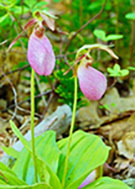 5/20 – Westchester County, HRM 33: For several weeks I have been enjoying many spring flowers. Today, I went looking and found a bounty of spring flowers, including false Solomon seal, may apple, Canada mayflower, wild geranium, shooting star, several species of trillium, and pink lady’s slipper orchid. While most people do not realize it, there are about 60 species of native orchids in New York State. (Photo of pink lady slipper courtesy of Edward Mertz) 5/20 – Westchester County, HRM 33: For several weeks I have been enjoying many spring flowers. Today, I went looking and found a bounty of spring flowers, including false Solomon seal, may apple, Canada mayflower, wild geranium, shooting star, several species of trillium, and pink lady’s slipper orchid. While most people do not realize it, there are about 60 species of native orchids in New York State. (Photo of pink lady slipper courtesy of Edward Mertz)
- Edward Mertz
[Pink lady’s slipper (Cypripedium acaule) is an orchid. Due to the often-unbridled zeal of orchid collectors, in the interest of preservation, we never give exact locations where they are found. Tom Lake]
5/20 – Yonkers, HRM 18: A second-grade class from Bank Street School in Manhattan came to the Sarah Lawrence Center for the Urban River at Beczak to help us seine the river. We chose to fish our net in the Beczak Marsh, and across eight hauls, we caught a bay anchovy (55 millimeters (mm)), two small striped bass (95,115 mm), and four silver-dollar-size blue crabs.
- Eli Caref, Katie Lamboy, Sam Macaluso, Natalia Bengiam, Brandon Respler
[Note: one inch = 25.4 millimeters (mm)]
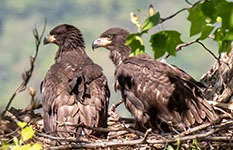 5/21 – Town of Poughkeepsie: Our best guess is that this was Day 59 for our two nestlings in bald eagle nest NY62. They look as big as small penguins and would seem to be on schedule for a predicted range of fledge dates of June 3 - 21 (the average is 72-90 days after hatching.) (Photo of bald eagles courtesy of Bob Rightmyer) 5/21 – Town of Poughkeepsie: Our best guess is that this was Day 59 for our two nestlings in bald eagle nest NY62. They look as big as small penguins and would seem to be on schedule for a predicted range of fledge dates of June 3 - 21 (the average is 72-90 days after hatching.) (Photo of bald eagles courtesy of Bob Rightmyer)
- Tom Lake
5/21 – Yonkers, HRM 18: We welcomed a second-grade class from Bank Street School in Manhattan to the Sarah Lawrence Center for the Urban River at Beczak to help us seine the river. We chose to fish our net in the Beczak Marsh, and across ten hauls, we caught seven mummichogs (65-90 mm), a striped bass (100 mm), and three quarter-size blue crabs.
- Eli Caref, Katie Lamboy, Sam Macaluso, Natalia Bengiam, Brandon Respler, Jan Manogca
5/21 – Yonkers, HRM 18: Our 9-11 grade students from the Bio-Chem program at Saunders High School in Yonkers checked their eel mops in the Hudson River this afternoon in search of glass eels fresh from the sea. The river had warmed to 65 degrees Fahrenheit (F). The 76 glass eels they collected showed darkening pigment – a change from their earlier translucency – as an adaptation to their new environment. They also caught two elvers, possibly last year’s glass eels.
- Brenda Jandres
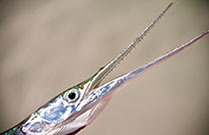 5/22 – Ulster County: Today near Kingston Point, I photographed an osprey carrying an impressive looking 18-inch-long Atlantic needlefish to a perch where it preened before taking off with the fish and heading north. (Photo of Atlantic needlefish courtesy of ChesapeakeBay.net) 5/22 – Ulster County: Today near Kingston Point, I photographed an osprey carrying an impressive looking 18-inch-long Atlantic needlefish to a perch where it preened before taking off with the fish and heading north. (Photo of Atlantic needlefish courtesy of ChesapeakeBay.net)
- Deborah Tracy-Kral
[Atlantic needlefish (Strongylura marina) are a salt-to-brackish water species that has been able to adapt to inshore waters. Defying their literature, they are now spawning in freshwater. A good indication as to how dynamic their presence has been in the estuary, in his Biological Survey of the Lower Hudson Watershed (1937), J.R. Greeley refers to Atlantic needlefish as “rare,” and notes that they “spawn in saltwater.” Needlefish are often found on the surface where they do line-of-sight predation with their long, tooth-studded jaws. They have a ventrally-adjusted lateral line that allows them to be directly on top and still maintain an air/water interface. Their one peculiarity is that when cooked (smoked), their bones turn Kelly green. They are actually quite tasty. Tom Lake]
5/22 – Yonkers, HRM 18: A second-grade class from Bank Street came to the Sarah Lawrence Center for the Urban River at Beczak to help us seine the river. Given the tide, we opted for the Beczak Marsh, and across eight hauls of our net, we caught seven mummichogs (40-90 mm), a striped bass (90 mm), a bay anchovy (50 m), three nickel-to-dime-sized blue crabs, and a shore shrimp.
- Katie Lamboy, Natalia, Brandon, Jan Manogca, Taylor Child
5/23 – Green Island, HRM 153: The tide was two hours into the ebb, and the air and water were filled with birds – a convention of cormorants. The long pool below the federal dam was a potpourri of fish. On red-and-white lead-head jigs (formerly known as shad darts) we hooked, landed, but mostly lost yellow perch, white perch, common carp, gizzard shad, smallmouth bass, striped bass, a buck American shad, and a hook-up with a huge fish that eventually broke my ten-pound-test line.
We could see schools of fish moving along the shore – darting along in an “S” fashion. They were river herring, probably blueback herring. The federal lock at Troy had opened on May 1, and the migrating bluebacks were eager to ascend the river, and negotiate the Waterford Flight, a series of five locks that lifts vessels (and fish) 170 feet above the Hudson River to the beginning of the Erie Canal and into the Mohawk River where they spawn. We also counted more than a dozen brant heading upriver on their way north. The water was 63 degrees F.
- Tom Lake, Phyllis Lake
 [Waterman Dery Bennett used to mark the seasons by noting how brant (Branta bernicla), a small species of goose, left Sandy Hook, NJ around Memorial Day after spending the winter and headed north. In his words, “They would shove off for the Canadian Arctic where they breed, fledge young, and then return around Columbus Day.” Tom Lake] (Photo of brant courtesy of Doug Weschler) [Waterman Dery Bennett used to mark the seasons by noting how brant (Branta bernicla), a small species of goose, left Sandy Hook, NJ around Memorial Day after spending the winter and headed north. In his words, “They would shove off for the Canadian Arctic where they breed, fledge young, and then return around Columbus Day.” Tom Lake] (Photo of brant courtesy of Doug Weschler)
5/23 – Yonkers, HRM 18: We hosted a class of fourth-grade students from Greenville School at the Sarah Lawrence Center for the Urban River at Beczak for a seining adventure. We chose our marsh to set our net, and across 12 hauls, we had a catch that fully amazed the students. It included bay anchovies (70-80 mm), mummichogs (60-80 mm), a young-of-year alewife (55 mm), two-dozen amazing quarter-sized blue crabs, and two shore shrimp.
- Jay Muller, Brandon Respler, Taylor Child
5/23 – Yonkers, HRM 18: Our 9-11 grade students from the Bio-Chem program at Saunders High School in Yonkers checked their eel mops in the Hudson River this afternoon in search of glass eels fresh from the sea. The river had cooled a bit (two degrees F) to 63 degrees. Different stages of different tides can make water temperature fluctuate. The 38 glass eels they collected continued to show darkening pigment, a change from their earlier translucency. They also caught seven blue crabs.
- Brenda Jandres
5/24 – Ulster County, HRM 76: Bug News. Two weeks ago, I saw my first monarch of the season flying down Main Street heading east in Rosendale. A few days later, some fortunate kindergarten students at Duzine Elementary found a female Polyphemus moth (Saturniidae family of silkworm moths). I brought my cricket cage with quarter-inch-wire mesh, placed her inside, and hung it outside their classroom window. She produced about 40 eggs before she was released. Two days ago, a female Cecropia moth (also Saturniidae family of silkworm moths) emerged from her cocoon and is now hanging in the same cage from my back porch and hopefully attracting a male.
- Betty Boomer
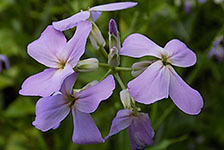 5/24 – Town of Poughkeepsie, HRM 68: One of the signs of the waning spring season is the appearance of Dame’s rocket (Hesperis matronalis) in the uplands and along the river and its tributaries. This naturalized wildflower, native to Eurasia and brought to North America in the 17th century, comes in white, pink, violet, and purple. Carried by spring breezes, its wonderfully sweet fragrance fills the air from mid-May through early June. (Photo of Dame's rocket courtesy of Tom Lake) 5/24 – Town of Poughkeepsie, HRM 68: One of the signs of the waning spring season is the appearance of Dame’s rocket (Hesperis matronalis) in the uplands and along the river and its tributaries. This naturalized wildflower, native to Eurasia and brought to North America in the 17th century, comes in white, pink, violet, and purple. Carried by spring breezes, its wonderfully sweet fragrance fills the air from mid-May through early June. (Photo of Dame's rocket courtesy of Tom Lake)
- Tom Lake, T.R. Jackson
5/24 – Dutchess County: Tom Hall has the eyes of an archaeologist. Walking along the river, he noticed a small piece of “worked” stone or chert, evidence of a human artisan, in the sand. It was a scraper, a side-scraper (25 x 22 mm), used to clean a fish, a gray squirrel, or process a pelt. Since the artifact was found out of context (not on a recognizable habitation site), it is impossible to date, except to say that it is likely very old. Scrapers have been a part of our tool kit in the Hudson Valley for 12,000 years.
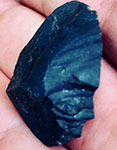 This dark, black, lithic stone is probably one of the Helderberg Escarpment cherts (possibly Glenerie). Being left-handed, the first thing I noticed was that this scraper may have been created for use by a right-handed person. This dark, black, lithic stone is probably one of the Helderberg Escarpment cherts (possibly Glenerie). Being left-handed, the first thing I noticed was that this scraper may have been created for use by a right-handed person.
There is a thesis for determining “handedness” in prehistoric artifacts, a fundamental assumption that If someone is working at a repetitive, long-term task, it seems reasonable to assume that the utilitarian tool (knife, scraper, chopper...) should feel comfortable in the person's hand (not cause abrasions or blisters.) This thesis evolved from examining more than 900 prehistoric artifacts.
When I come across such tools, the first thing I do is heft it in each hand and make an evaluation as to which hand it feels most comfortable in. On average, about half of such tools suggest "handedness." Of those examined, tools held in the left hand seemed to be present at about a 1:3 ratio. This does not necessarily mean that the user was left-handed, but it suggests at least some ambidexterity. Very often, close analyses reveal burnishing on the "business" side and some backing or dulling of the reverse side. These percentages seem to suggest a greater use of left-hands in prehistory (left-handedness in contemporary society is about 1:10). Dean Falk (1980) and Briana Pobiner (1999) are excellent sources for further investigation. (Photo of Indian artifact (scraper) courtesy of Tom Hall)
- Tom Lake
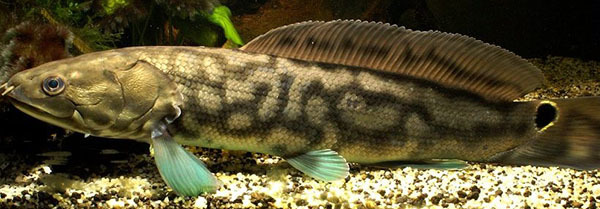
Spring-Summer 2019 Natural History Programs
Wednesday, July 10 - Thursday July 11 (9:00 AM - 5:00 PM)
2019 Teachers on the Estuary and Living Environment Institute
Wonders of Wetlands (15 credit hours for NYS certified teachers and administrators)
Five Rivers Environmental Education Center, 56 Game Farm Road, Delmar, New York
Join us this summer as we explore the Wonders of Wetlands. Teachers will spend two days gaining valuable knowledge and learning new curricula. We will use interdisciplinary approaches with the guidance of experts like EPA Award Winner Chris Bowser.
Cost: $50.00 for materials, supplies, and refreshments (light dinner on Thursday)
To register, e-mail drew.hopkins@dec.ny.gov
Tuesday, August 20 - Thursday August 22 (9:00 AM - 4:00 PM)
2019 Teachers on the Estuary and Living Environment Institute
Amazing Watersheds (22 credit hours for NYS certified teachers and administrators)
Five Rivers Environmental Education Center, 56 Game Farm Road, Delmar, New York
Join us this summer as we explore amazing watersheds. Teachers will spend three days gaining valuable knowledge and learning new curricula while using interdisciplinary approaches to explore watersheds. Some easy hiking on trails is involved.
Cost: $60.00 for materials, supplies, and refreshments (dinner provided on Wednesday)
To register, e-mail drew.hopkins@dec.ny.gov
Saturday, September 14 - 1:00- 4:00 PM
Science on the River
Norrie Point Environmental Education Center, Staatsburg
We would like to invite you to our open house featuring hands-on, interactive demonstrations, displaying scientific research and discovery on the estuary and in the Hudson Valley. Activities, with educational games and crafts, will be targeted towards both young and adult audiences.
For more information, email maija.niemisto@dec.ny.gov or call 845-889-4745 x109.
Hudson River: Striped Bass Cooperative Angler Program
You can share your fishing trip information and help biologists understand and manage our Hudson River striped bass fishery.
Here’s how it works: Fill out a logbook provided by us whenever you fish on the Hudson River (by boat or from shore). Record general location, time, gear used, what you caught (or if you didn’t catch anything) and return the logbook when you are done fishing for the season. You’ll receive an annual newsletter summarizing the information in addition to the latest news regarding regulations and the river. Whether you catch-and-release or take home a keeper, you can be part of the Cooperative Angler Program.
Join today by contacting: jessica.best@dec.ny.gov, or call 845-256-3009
- Jessica Best
Hudson River Miles
The Hudson is measured north from Hudson River Mile 0 at the Battery at the southern tip of Manhattan. The George Washington Bridge is at HRM 12, the Tappan Zee 28, Bear Mountain 47, Beacon-Newburgh 62, Mid-Hudson 75, Kingston-Rhinecliff 95, Rip Van Winkle 114, and the Federal Dam at Troy, the head of tidewater, at 153. The tidal section of the Hudson constitutes a bit less than half the total distance – 315 miles – from Lake Tear of the Clouds to the Battery. Entries from points east and west in the watershed reference the corresponding river mile on the mainstem.
To Contribute Your Observations or to Subscribe
The Hudson River Almanac is compiled and edited by Tom Lake and emailed weekly by DEC's Hudson River Estuary Program. Share your observations by e-mailing them to trlake7@aol.com.
To subscribe to the Almanac (or to unsubscribe), use the links on DEC's Hudson River Almanacor DEC Delivers web pages.
Discover New York State Conservationist - the award-winning, advertisement-free magazine focusing on New York State's great outdoors and natural resources. Conservationist features stunning photography, informative articles and around-the-state coverage. Visit the Conservationist webpage for more information.
Useful Links
National Oceanic and Atmospheric Administration online tide and tidal current predictions are invaluable when planning Hudson River field trips.
For real-time information on Hudson River tides, weather and water conditions from sixteen monitoring stations, visit the Hudson River Environmental Conditions Observing System website.
DEC's Smartphone app for iPhone and Android is now available at: New York Fishing, Hunting & Wildlife App.
Adventure NY
Under Governor Cuomo's Adventure NY initiative, DEC is making strategic investments to expand access to healthy, active outdoor recreation, connect more New Yorkers and visitors to nature and the outdoors, protect natural resources, and boost local economies. This initiative will support the completion of more than 75 projects over the next three years, ranging from improvements to youth camps and environmental education centers to new boat launches, duck blinds, and hiking trails. Read more about the Adventure NY initiative. For more information on planning an outdoor adventure in New York State, visit DEC's website at http://www.dec.ny.gov/outdoor.
Information about the Hudson River Estuary Program is available on DEC's website at http://www.dec.ny.gov/lands/4920.html.
|


 5/19 – Putnam County, HRM 52: This was our first trip to Constitution Marsh Sanctuary – a jewel of a place. Hiking in the hilly wooded section before the boardwalk, we heard a gasp from hikers ahead of us. They had startled a five-foot-long black snake sunning on a rock. The snake hissed at them, slithered into the underbrush, and being very agile and a good climber, went up a tree. (Photo of eastern rat snake courtesy of Virginia Herpetological Society)
5/19 – Putnam County, HRM 52: This was our first trip to Constitution Marsh Sanctuary – a jewel of a place. Hiking in the hilly wooded section before the boardwalk, we heard a gasp from hikers ahead of us. They had startled a five-foot-long black snake sunning on a rock. The snake hissed at them, slithered into the underbrush, and being very agile and a good climber, went up a tree. (Photo of eastern rat snake courtesy of Virginia Herpetological Society) 5/18 – Albany County, HRM 135: We were kayaking an inlet off the river at the Binnen Kill when we came upon three deadfalls in the water covered with map turtles. We counted no fewer than thirty. Some were shedding their scutes (plate-like scales). (Photo of map turtles courtesy of Sharon Askew)
5/18 – Albany County, HRM 135: We were kayaking an inlet off the river at the Binnen Kill when we came upon three deadfalls in the water covered with map turtles. We counted no fewer than thirty. Some were shedding their scutes (plate-like scales). (Photo of map turtles courtesy of Sharon Askew) 5/20 – Westchester County, HRM 33: For several weeks I have been enjoying many spring flowers. Today, I went looking and found a bounty of spring flowers, including false Solomon seal, may apple, Canada mayflower, wild geranium, shooting star, several species of trillium, and pink lady’s slipper orchid. While most people do not realize it, there are about 60 species of native orchids in New York State. (Photo of pink lady slipper courtesy of Edward Mertz)
5/20 – Westchester County, HRM 33: For several weeks I have been enjoying many spring flowers. Today, I went looking and found a bounty of spring flowers, including false Solomon seal, may apple, Canada mayflower, wild geranium, shooting star, several species of trillium, and pink lady’s slipper orchid. While most people do not realize it, there are about 60 species of native orchids in New York State. (Photo of pink lady slipper courtesy of Edward Mertz) 5/21 – Town of Poughkeepsie: Our best guess is that this was Day 59 for our two nestlings in bald eagle nest NY62. They look as big as small penguins and would seem to be on schedule for a predicted range of fledge dates of June 3 - 21 (the average is 72-90 days after hatching.) (Photo of bald eagles courtesy of Bob Rightmyer)
5/21 – Town of Poughkeepsie: Our best guess is that this was Day 59 for our two nestlings in bald eagle nest NY62. They look as big as small penguins and would seem to be on schedule for a predicted range of fledge dates of June 3 - 21 (the average is 72-90 days after hatching.) (Photo of bald eagles courtesy of Bob Rightmyer) 5/22 – Ulster County: Today near Kingston Point, I photographed an osprey carrying an impressive looking 18-inch-long Atlantic needlefish to a perch where it preened before taking off with the fish and heading north. (Photo of Atlantic needlefish courtesy of ChesapeakeBay.net)
5/22 – Ulster County: Today near Kingston Point, I photographed an osprey carrying an impressive looking 18-inch-long Atlantic needlefish to a perch where it preened before taking off with the fish and heading north. (Photo of Atlantic needlefish courtesy of ChesapeakeBay.net) [Waterman Dery Bennett used to mark the seasons by noting how brant (Branta bernicla), a small species of goose, left Sandy Hook, NJ around Memorial Day after spending the winter and headed north. In his words, “They would shove off for the Canadian Arctic where they breed, fledge young, and then return around Columbus Day.” Tom Lake] (Photo of brant courtesy of Doug Weschler)
[Waterman Dery Bennett used to mark the seasons by noting how brant (Branta bernicla), a small species of goose, left Sandy Hook, NJ around Memorial Day after spending the winter and headed north. In his words, “They would shove off for the Canadian Arctic where they breed, fledge young, and then return around Columbus Day.” Tom Lake] (Photo of brant courtesy of Doug Weschler) 5/24 – Town of Poughkeepsie, HRM 68: One of the signs of the waning spring season is the appearance of Dame’s rocket (Hesperis matronalis) in the uplands and along the river and its tributaries. This naturalized wildflower, native to Eurasia and brought to North America in the 17th century, comes in white, pink, violet, and purple. Carried by spring breezes, its wonderfully sweet fragrance fills the air from mid-May through early June. (Photo of Dame's rocket courtesy of Tom Lake)
5/24 – Town of Poughkeepsie, HRM 68: One of the signs of the waning spring season is the appearance of Dame’s rocket (Hesperis matronalis) in the uplands and along the river and its tributaries. This naturalized wildflower, native to Eurasia and brought to North America in the 17th century, comes in white, pink, violet, and purple. Carried by spring breezes, its wonderfully sweet fragrance fills the air from mid-May through early June. (Photo of Dame's rocket courtesy of Tom Lake) This dark, black, lithic stone is probably one of the Helderberg Escarpment cherts (possibly Glenerie). Being left-handed, the first thing I noticed was that this scraper may have been created for use by a right-handed person.
This dark, black, lithic stone is probably one of the Helderberg Escarpment cherts (possibly Glenerie). Being left-handed, the first thing I noticed was that this scraper may have been created for use by a right-handed person.